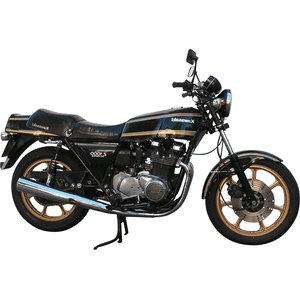Kawasaki Z 1000 (2003–2006): A Super Naked That Still Thrills
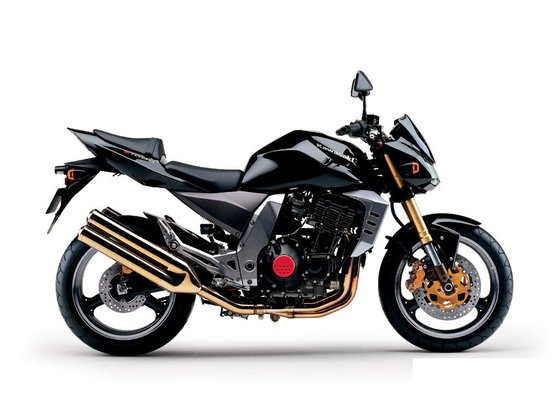
Introduction
When Kawasaki unleashed the Z 1000 in 2003, it wasn’t just launching a motorcycle—it was declaring war on convention. Dubbed the world’s first “Super Naked,” this bike took the raw DNA of Kawasaki’s sportbike lineage, stripped away the bodywork, and injected a dose of unapologetic aggression. Riding the 2003–2006 Z 1000 today feels like gripping the handlebars of a time machine set to “adrenaline.” With its 953cc inline-four engine, snarling exhaust note, and streetfighter swagger, this machine remains a benchmark for visceral motorcycling. Let’s dive into why this generation of the Z 1000 still commands respect—and grins—from riders who crave authenticity.
Design: Brutalist Art on Two Wheels
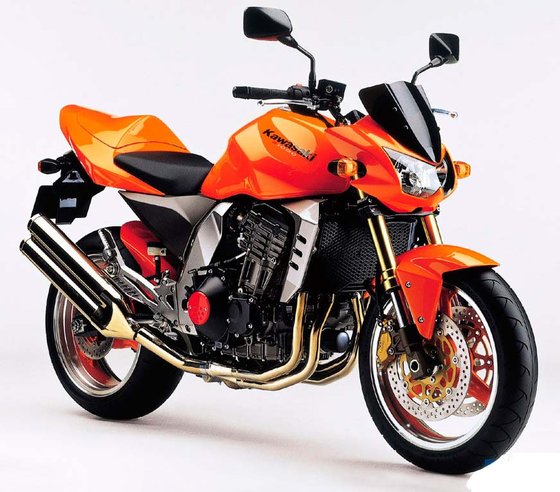
The Z 1000’s design is a masterclass in purposeful minimalism. Its “bikini cowl” dual headlights—a signature Kawasaki trait—stare ahead like predator eyes, while the muscular fuel tank (crafted from corrosion-resistant galvanized steel) slopes aggressively toward a minimalist seat. The quad stainless-steel mufflers, heat-treated to a golden hue, aren’t just exhaust pipes; they’re jewelry for anarchists.
Standout Features:
- LED Taillight: A rarity in the early 2000s, the sleek LED strip embedded in the seat cowl gave the Z 1000 a futuristic edge.
- Exposed Chassis: The diamond steel frame isn’t hidden beneath plastic. Instead, it’s showcased, flaunting the bike’s mechanical honesty.
- Ergonomics: The 820 mm (32.3 in) seat height accommodates most riders, while the slightly forward-leaning posture balances control and comfort.
Color options like Candy Flat Raw Plasma Blue and Metallic Raw Titanium emphasized its industrial aesthetic. This wasn’t a bike designed to blend in—it was built to dominate parking lots and canyon roads alike.
Performance: Unleashing the Beast
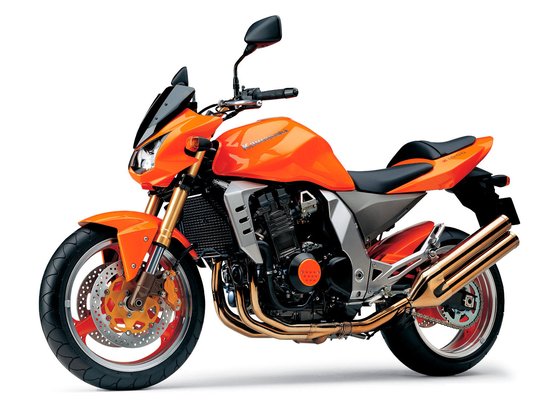
At the heart of the Z 1000 lies a 953cc inline-four engine, derived from the ZX-9R but bored out for mid-range muscle. With 127 HP at 10,000 RPM and 95.6 Nm (70.5 lb-ft) of torque at 8,000 RPM, this engine isn’t subtle. Throttle response is immediate, thanks to 38mm throttle bodies and digital fuel injection (DFI), a cutting-edge feature in its era.
Riding Impressions:
- Low-End Grunt: Below 3,500 RPM, the Z 1000 feels docile—almost polite. But twist the throttle past that point, and the engine transforms into a snarling beast. The surge from 5,000 to 10,000 RPM is addictive, accompanied by a vibration through the bars that feels like the bike’s heartbeat.
- Top-End Scream: Redline at 11,000 RPM comes quickly, urging shifts from the crisp 6-speed transmission. Kawasaki claims a top speed of 238 km/h (148 mph), and the Z 1000 delivers—though sustained highway runs will leave you clinging like a koala.
- Fuel Efficiency: Averaging 18.9 km/L (44.4 mpg), it’s surprisingly frugal for a liter-class bike. The 18L (4.8 gal) tank means ~350 km (217 mi) between fill-ups.
The exhaust note deserves its own accolade. The quad mufflers emit a bass-heavy growl that’s more Slipknot concert than symphony orchestra—perfect for announcing your arrival.
Handling: Precision Meets Playfulness
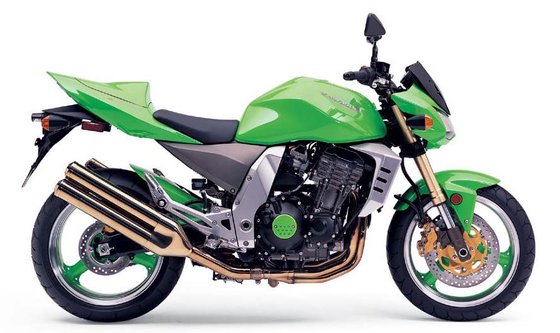
Kawasaki’s diamond frame, with the engine as a stressed member, creates a chassis that’s rigid yet flickable. The 41mm inverted fork (rebound and preload adjustable) and Uni-Trak rear suspension (piggyback reservoir, preload/rebound adjustments) strike a balance between sporty stiffness and street compliance.
Key Dynamics:
- Flickability: With a wheelbase of 1,420 mm (55.9 in) and 25° rake, the Z 1000 carves corners like a sportbike. The wide handlebars offer leverage for quick direction changes.
- Braking: Dual 300mm front discs with 4-piston calipers lack initial bite but deliver strong stopping power once engaged. The rear 292mm disc is adequate—though most braking happens upfront.
- Weight Distribution: At 221 kg (487 lbs) wet, the Z 1000 feels lighter than its specs suggest. The low center of gravity aids stability during aggressive leans.
Ride quality is firm, communicating every crack in the pavement. This isn’t a touring bike—it’s a backroad bruiser that rewards skilled inputs.
Competition: How the Z 1000 Stacks Up
The early 2000s naked bike arena was fierce. Here’s how the Z 1000 fared against rivals:
- Honda CB 1000R (2008+):
- More refined, less raw. Honda’s inline-four prioritized smoothness over theatrics.
-
Lacked the Z 1000’s visual drama but offered better wind protection.
-
Yamaha FZ1 (2001–2005):
- Detuned R1 engine with a focus on comfort.
-
Softer suspension and upright ergonomics made it a better commuter but less thrilling.
-
Suzuki GSX-S 750 (2015+):
-
Smaller displacement but similar ethos. Suzuki’s later offering emphasized accessibility over outright aggression.
-
Triumph Speed Triple (2000s):
- The Brit’s 955cc triple rivaled the Z 1000’s character with a torquier engine and iconic bug-eyed headlights.
Verdict: The Z 1000 stood out for its unapologetic rawness. While competitors chased refinement, Kawasaki doubled down on adrenaline—a decision that’s aged brilliantly.
Maintenance: Keeping the Beast Alive
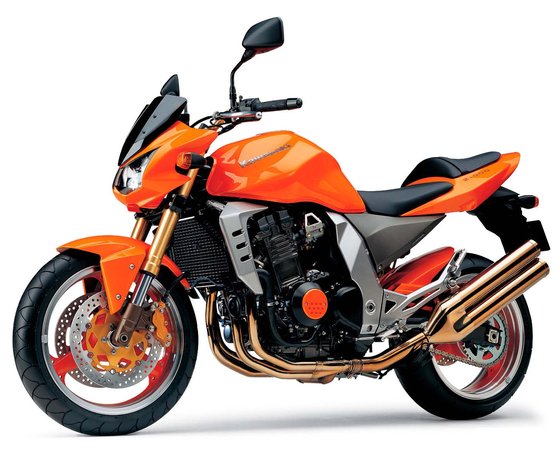
Owning a Z 1000 isn’t just about riding—it’s about stewardship. Here’s what to watch:
- Engine Oil: Use 10W-40 synthetic. Capacity is 3.3L (3.5 qt) with filter changes every 6,000 km (3,700 mi).
- Valve Adjustments: Check every 42,000 km (26,000 mi). Intake valves: 0.15–0.24 mm, exhaust: 0.22–0.31 mm (cold).
- Cooling System: Replace coolant every 2 years. Capacity: 2.9L (3.1 qt).
- Chain Care: The 112-link chain demands regular lubrication. Sprockets (16T front/42T rear) wear faster if neglected.
- Brakes: Upgrade to sintered pads for sharper bite. Fluid changes (DOT 4) every 2 years prevent sponginess.
Common Upgrades:
- Aftermarket Exhaust: Unleash the engine’s full voice with a slip-on system.
- Suspension Tweaks: Stiffer springs and adjustable dampers enhance cornering precision.
- Bar-End Mirrors: Improve rear visibility while enhancing the streetfighter look.
Conclusion: A Timeless Thrill
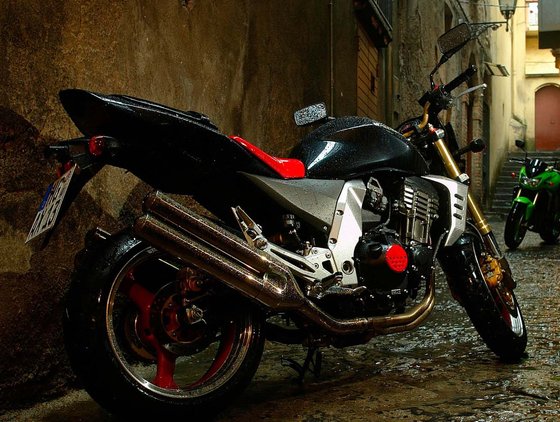
The 2003–2006 Kawasaki Z 1000 isn’t just a motorcycle—it’s a rebellion on wheels. Its combination of brute-force power, razor-sharp handling, and head-turning design ensures it remains relevant decades later. Yes, it vibrates. Yes, the mirrors are useless. And yes, you’ll arrive everywhere slightly out of breath. But that’s the point. This bike doesn’t coddle; it exhilarates.
For riders seeking a machine that prioritizes passion over practicality, the Z 1000 is a modern classic. And at MOTOPARTS.store, we’re here to help you keep yours roaring—whether you need performance upgrades, OEM replacements, or just a fresh set of grips to hang on tighter.
Stay naked. Stay wild.
Specifications sheet
| Engine | |
|---|---|
| Stroke: | Four-stroke |
| Max power: | 93 kW | 125.0 hp |
| Max torque: | 96 Nm |
| Fuel system: | Digital fuel injection with 38mm throttle bodies |
| Lubrication: | Wet sump |
| Max power @: | 10000 rpm |
| Displacement: | 953 ccm |
| Max torque @: | 8000 rpm |
| Configuration: | Inline |
| Cooling system: | Liquid-cooled with radiator and oil cooler |
| Compression ratio: | 11.2:1 |
| Number of cylinders: | 4 |
| Dimensions | |
|---|---|
| Wheelbase: | 1420 mm (55.9 in) |
| Dry weight: | 198 |
| Wet weight: | 221 |
| Seat height: | 820 mm (32.3 in) |
| Overall width: | 770 mm (30.3 in) |
| Overall height: | 1055 mm (41.5 in) |
| Overall length: | 2080 mm (81.9 in) |
| Ground clearance: | 145 mm (5.7 in) |
| Fuel tank capacity: | 18 L (4.8 US gal) |
| Drivetrain | |
|---|---|
| Clutch: | Wet, multiple discs, cable-operated |
| Final drive: | chain |
| Chain length: | 112 |
| Transmission: | 6-speed |
| Rear sprocket: | 42 |
| Front sprocket: | 16 |
| Maintenance | |
|---|---|
| Rear tire: | 190/50-z-17 |
| Engine oil: | 10W40 |
| Front tire: | 120/70-z-17 |
| Idle speed: | 1100 ± 50 RPM |
| Break fluid: | DOT 4 |
| Spark plugs: | NGK CR9EK |
| Spark plug gap: | 0.8 |
| Coolant capacity: | 2.9 |
| Forks oil capacity: | 0.8 |
| Engine oil capacity: | 3.3 |
| Engine oil change interval: | Every 5000km or 2 years |
| Valve clearance (intake, cold): | 0.15–0.24 mm |
| Valve clearance check interval: | 24,000 km / 15,000 mi |
| Valve clearance (exhaust, cold): | 0.22–0.31 mm |
| Recommended tire pressure (rear): | 2.9 bar (42 psi) |
| Recommended tire pressure (front): | 2.5 bar (36 psi) |
| Chassis and Suspension | |
|---|---|
| Rake: | 24° |
| Frame: | High-tensile steel diamond frame |
| Trail: | 102 mm (4.0 in) |
| Rear brakes: | Single 292mm disc with 2-piston caliper |
| Front brakes: | Dual 300mm semi-floating discs with 4-piston calipers |
| Rear suspension: | Uni-Trak linkage system with piggyback reservoir shock, adjustable rebound damping and spring preload |
| Front suspension: | 41mm inverted cartridge fork, adjustable rebound damping and spring preload |
| Rear wheel travel: | 136 mm (5.4 in) |
| Front wheel travel: | 120 mm (4.7 in) |
| Additional Specifications | |
|---|---|
| Instruments: | LCD tachometer, digital speedometer, fuel gauge, clock, and temperature display |
| Exhaust system: | 4-into-2-into-4 stainless steel mufflers with KLEEN catalyst |



